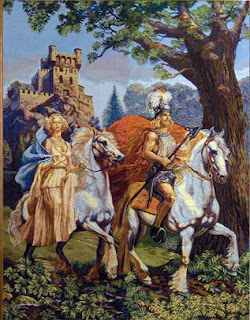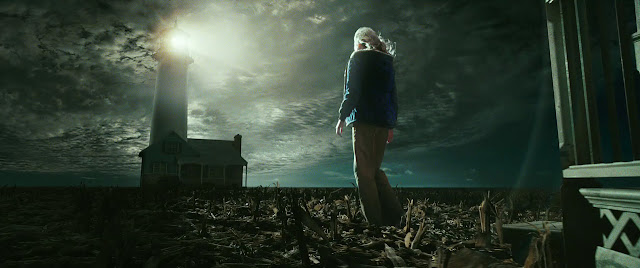 |
| The one picture I could find of Margaret Horton Potter |
Though few of the details are known, something occurred to have Margaret have some sort of mental breakdown. On May 5th, 1910 she was legally declared insane and ordered to a sanitarium. Life started to spiral down for her from there. Even after her release from the mental hospital later, the court still signed over her estate to be managed by an executor and her husband filed for divorce in October of 1910, claiming she was a habitual drunk. (I'm guessing being a lawyer he probably didn't have too much trouble getting his way). To top off this real life tragedy, on December 22, 1911 Mrs Potter was found dead at the Chicago Beach Hotel. The coroner ruled it an "accidental" morphine overdose. She was just 30 years old!
Her close friends claimed that Potter was using morphine for pain related to a heart condition she had. Her brother stated that 4 months prior to her death, she mentioned being "sick of life" but he didn't believe she meant to end her life. I don't know ... all seems like a lot of strange coincidences....
 |
| Chicago Beach Hotel |
Given the dark, sad tone to The Castle of Twilight, it makes me wonder if Potter had some melancholy sort of inner demons she was trying to work out that maybe caused her to implode? Castle tells the story of the 14th century ruling family of Le Crepuscule Castle, a 12th century castle that sits right on the Breton Coast of England, the sea mists and crashing waves adding to the dark, contemplative natures of the castle inhabitants.
To me, it seemed everyone's issues seemed to be a result of Eleanore, the widowed "lady of the house", mother to Laure and Gerault (heir to the castle). Eleanore has a bummer mix of depression and over-zealous religious tendencies. She basically just wanders about the castle in black robes telling whoever will listen how much her life sucks and pushes her religious zeal onto her kids. Strangely though, she gets upset when her daughter takes to it and decides to become a nun! She claims God has stolen her daughter from her! Can this woman find nothing to be happy about??
Laure, Eleanor's daughter decides to become an noviate or "starter" nun at the Virgins of Magdalene Convent. Only being 17 though, Laure quickly finds that even after taking her vows of poverty, chastity and all that and changing her name to "Angelique", she's still just a teenage girl at heart, feeling the need to get her groove on. Into her life comes ladies man/troubador, Bertrand Flammecouer, whose character is described in the line, "As long as he should be the center of interest, he was never bored." Reading that, I pictured Gaston from Beauty and the Beast, who was more in love with himself than anyone else could possibly be : -P
Laure falls prey to his charms and sneaks out of the convent in the dark of night, running away with him to wherever he should lead (*She and Lydia Bennet from P&P should compare experience notes lol).
So Eleanore doesn't want a nun for a daughter, but doesn't want her running off with Rico Suave... Guess since she can't chew out her impetuous daughter, she starts in on her son with "Why don't you find a nice girl and settle down?" Weeelll... turns out her son is still mourning the death of his cousin Lenore he was in love with, a death he feels partly responsible for. I can understand how that could be hard to shake off! But for his mother's sake, Gerault goes traveling and months later comes back with a wife. Weird though, of all the women in the world, he runs into a girl from the next town over also named Lenore! For some reason though, Gerault, being a knight and falconer, decides to add "cradle robber" to his list of titles, bringing home a child bride barely into her teens but noted for her "golden beauty" by whoever sees her. So the story questions, does he love her? Can he love her? Is he a total douche?
Poor Lenore seems to be stuck in a situation where she marries as a result of teenage lust and infatuation (though she having no previous experience with men has no idea what her husband wants from her - but ooo she just knows he's hot in that "older, experienced" kind of way). Her bliss is interrupted when she realizes that her new home at Le Crepuscule seems to be a perpetual buzzkill for everyone who enters. No one stays happy in that place! But the story almost begs the question - is it really the people or the place that this invasive melancholy stems from?? Alixe, an adopted, tomboy-ish daughter of Eleanore's, perhaps one of the most balanced residents of Le Crepuscule and someone who is essentially treated as the castle's "red headed step child" watches all the soap operas going on and continually claims she's "so outta here" but something about the place keeps her from going anywhere.. it's eerie how much this story reminded me of some Edgar Allan Poe stories.
By the way, the style of writing in this novel is beautiful!! Just check out the novel's foreword:
“ I deliver up to you my simple story knowing that the first suggestion of historical novel will bring before you an image of dreary woodenness and unceasing carnage. Yet if you will have the graciousness but to unlock my castle door you will find within only two or three quiet folk who will distress you with no battles nor strange oaths Even in the days of rival Princes and never- ending wars there dwelt still a few who took no part in the moil of life but lived with gentle pleasures and unvoiced sorrows somewhat as you and I; wherefore I pray you, cross the moat. The drawbridge is down for you and will not be raised, if, after introduction to the Chatelaine you desire speedily to retreat.”
M.H.P.
This alone reminded me of when I was a kid, reading Robin Hood or The Arthurian Legends for the first time. It's total escapism from page 1! Also similar to the Arthurian Legends, just when you thought things were looking up for a character, yet more tragedies fall... but that what makes for great writing for me - even if there is tragedy, it's written so eloquently, you can't help but keep reading, asking Where did Laure go? Will she come back? Will Gerault and his Lenore #2 work it out? Will Eleanore freakin' cheer up??
I think one of my favorite elements of this novel was how easy it was to picture everything. The characters were realistic, the environments were described in such a way that I could almost draw the places. Plus it was interesting to learn archaic words and customs not familiar today, such as St. Sylvestre's Eve (now called New Year's Eve) and the really cool tradition of leaving the draw bridge down on castles. By ecclesiastical law, from Christmas to New Year, castles were required to leave draw bridges down 24/7 , allowing anyone from criminal to count to enter, the families of the castles were expected to feed their visitors and no one was allowed to fight in any way during this time. I just loved the sense of charity behind this tradition! Really living the spirit of Christmas :-)
In her dedication, Potter mentioned that this story was inspired by a piece of music, presumably Nocturne - Opus 54, #4 by Edvard Grieg, the sheet music featured on the page following the dedication, which you can listen to here:
It's a pretty piece, but it amazes me Potter thought of a story such as Castle of Twilight just from this. At any rate, if you come across a copy, definitely check it out - perfect rainy day book!


















































